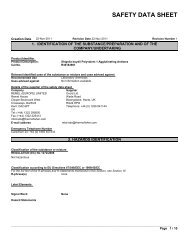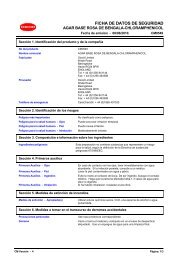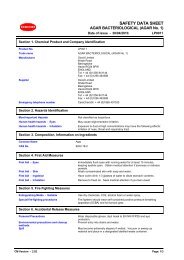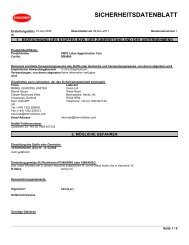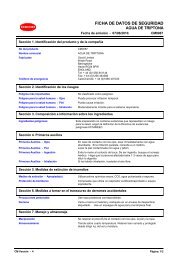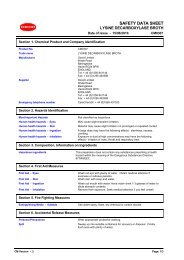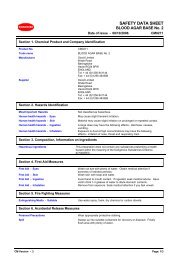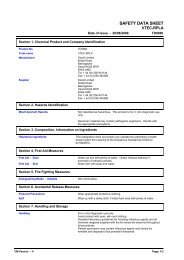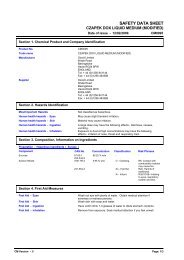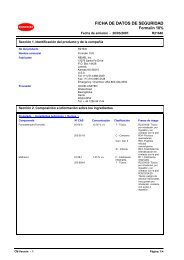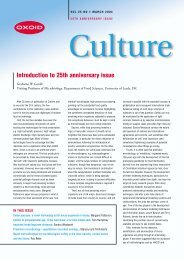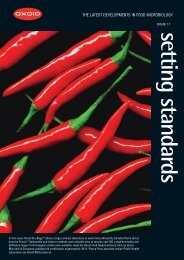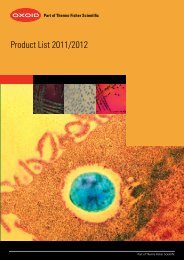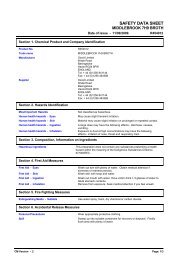IMAGEN™ Adenovirus - Oxoid
IMAGEN™ Adenovirus - Oxoid
IMAGEN™ Adenovirus - Oxoid
Create successful ePaper yourself
Turn your PDF publications into a flip-book with our unique Google optimized e-Paper software.
1 INTENDED USE<br />
The IMAGEN <strong>Adenovirus</strong> test is a qualitative direct immunofluorescence test for the detection of<br />
adenovirus antigen in clinical specimens and the confirmation of adenovirus in cell cultures.<br />
2 SUMMARY<br />
<strong>Adenovirus</strong>es are non-enveloped DNA viruses of icosahedral symmetry. The family Adenoviridae comprise<br />
2 genera, mammalian adenoviruses (Mastadenoviruses) and avian adenoviruses (Aviadenoviruses). 1 At<br />
least 47 known serotypes of human adenovirus have been identified and characterised by<br />
haemagglutination, neutralisation, DNA-hybridization and restriction endonuclease analysis of adenoviral<br />
DNA. 1,2,3,4<br />
Human adenoviruses are associated with a wide range of clinical disease in both immunocompetent and<br />
immunocompromised individuals which include infections of the respiratory tract, conjunctiva and gastrointestinal<br />
tract. 3,5 Infections are common in children and can occur sporadically or in outbreaks.<br />
Approximately 5% of acute respiratory disease in children and 10% of febrile illnesses and childhood<br />
pneumonias have been associated with adenovirus infection. 3,6,7<br />
<strong>Adenovirus</strong> infections of the eye may lead to pharyngo-conjunctival fever, follicular conjunctivitis or<br />
epidemic keratoconjunctivitis. 3,8<br />
<strong>Adenovirus</strong> serotypes 40 and 41 are commonly associated with viral gastroenteritis in infants and are<br />
reported to be responsible for 4-15% of nosocomial infections in paediatric wards. 3,9,10 In<br />
immunocompromised patients (eg transplant or AIDS patients) severe systemic infections can occur which<br />
can be life threatening. 3<br />
The laboratory diagnosis of adenovirus infection plays an important role in patient management and<br />
enables effective management and control of outbreaks. Diagnostic methods include direct detection of<br />
virus or viral proteins in clinical specimens (eg nasopharyngeal aspirates), isolation of viable virus in cell<br />
culture monolayers inoculated with respiratory, conjunctival or faecal specimens, and detection of<br />
adenovirus specific immunoglobulins. 3,5<br />
Isolation of adenoviruses from clinical specimens can be accomplished in continuous cell lines of mainly<br />
epithelial origin including HeLa, HEp-2, KB and 293 cell lines, in which adenoviruses may exhibit<br />
characteristic cytopathic effect. 3,5<br />
A range of techniques have been used to confirm the identification of adenovirus isolates including<br />
neutralisation tests, radioimmunoassay, DNA hybridisation, electron microscopy and DNA<br />
electrophoretyping. 11,12,13,14,15 These techniques can be complex, laborious and often inappropriate for<br />
routine use.<br />
Recently indirect immunofluorescence tests or enzyme-immunoassays (eg IDEIA <strong>Adenovirus</strong>) using<br />
genus specific monoclonal or polyclonal antibodies have been described for the direct detection of<br />
adenovirus in clinical specimens or cell culture monolayers. 15,16,17<br />
Direct immunofluorescence tests utilising specific monoclonal antibodies offer a rapid sensitive and specific<br />
method for the direct detection of adenoviruses in clinical specimens such as nasopharyngeal aspirates and<br />
conjunctival smears or for the confirmation of adenovirus isolates in cell culture monolayers.<br />
IMAGEN <strong>Adenovirus</strong> is a direct immunofluorescence test for the detection and identification of human<br />
adenovirus serotypes in clinical specimens or cell cultures. The test utilises a genus specific monoclonal<br />
antibody to detect an epitope of adenovirus hexon proteins which is expressed in all known human<br />
adenovirus serotypes. 18<br />
1/37 K6100EFG



